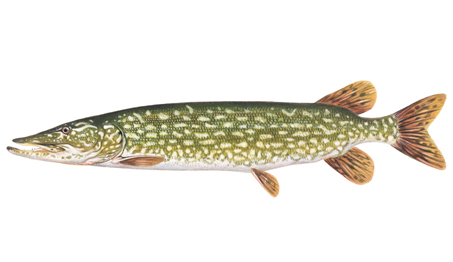Common Names: northern pike, pike, northern, jackfish
Habitat
Pike can survive in a wide variety of habitats. They prefer lakes with shallow weedy bays to inhabit in the spring and fall, and deeper water that they retreat to during the summer. Their preferred temperature for growth is around 21 ºC (70 ºF). Pike are widely dispersed across the province.
Spawning Patterns
Pike are spring spawners. Spawning begins just after ice out in April or May. They spawn during the day in marshy areas, or heavily vegetated bays, often in water less than 1 foot (30 cm) deep. The females have an average of 9000 eggs/lb of body weight. Eggs hatch in 4–14 days, depending on water temperature. Females mature at age 3 to 6.
Diet
Pike feed very aggressively, eating almost anything they can ingest. Diet items include fish, frogs, crayfish, muskrats and ducklings. They prefer large food items but seem to be opportunistic, taking whatever they come across.
Age and Size
Pike can be relatively long lived, up to 24 years. In most populations, the females grow faster and generally live longer.
Fishing Tips
Pike can be readily captured in both open water and through the ice. They are strong fighters and make an excellent meal. Some of the best fishing for pike is immediately following ice out. They can be caught by casting or trolling big spoons or plugs, and can also be captured by fishing large spinner baits along weedlines in shallow bays. Using very large minnows in deeper water can be effective in the summer. When filleting a pike take caution to remove the “Y” bone. Many wild game and fish cookbooks feature details of this process.
Fish illustration ©CURTIS ATWATER (www.natureartists.com/atwaterc.htm)









